
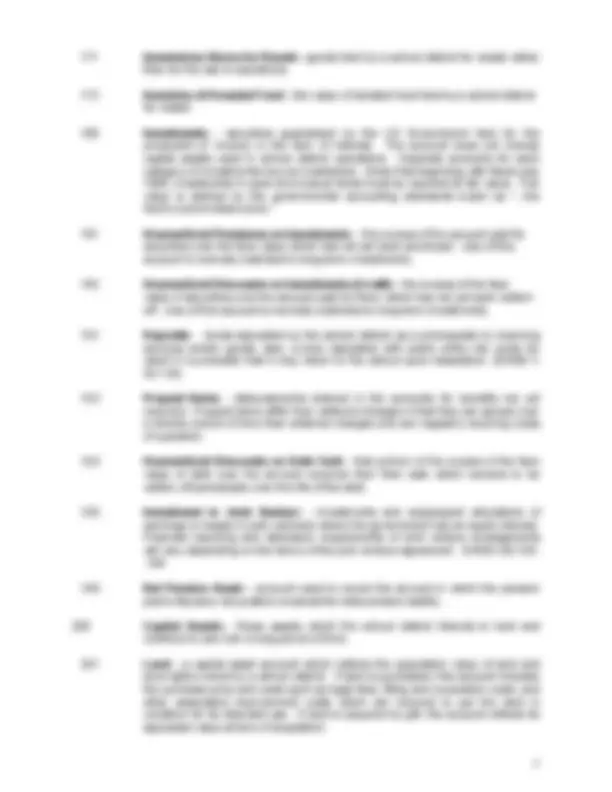
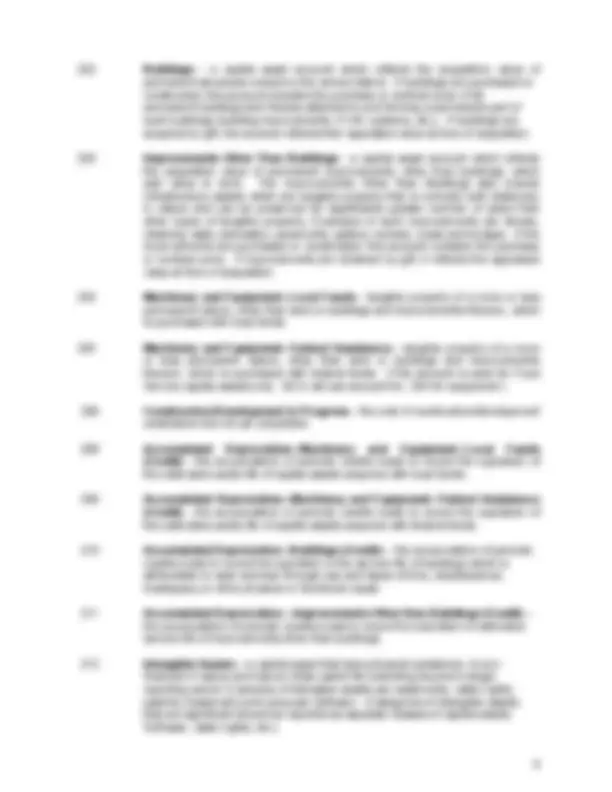
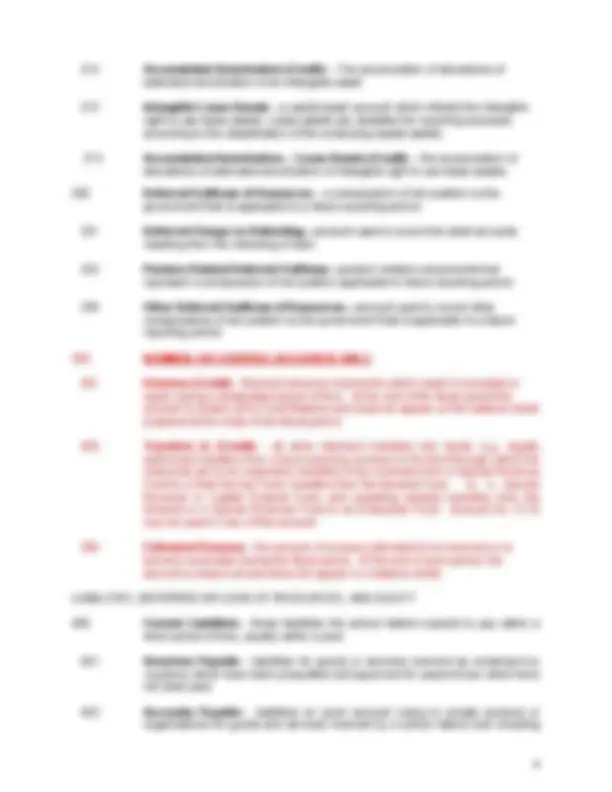
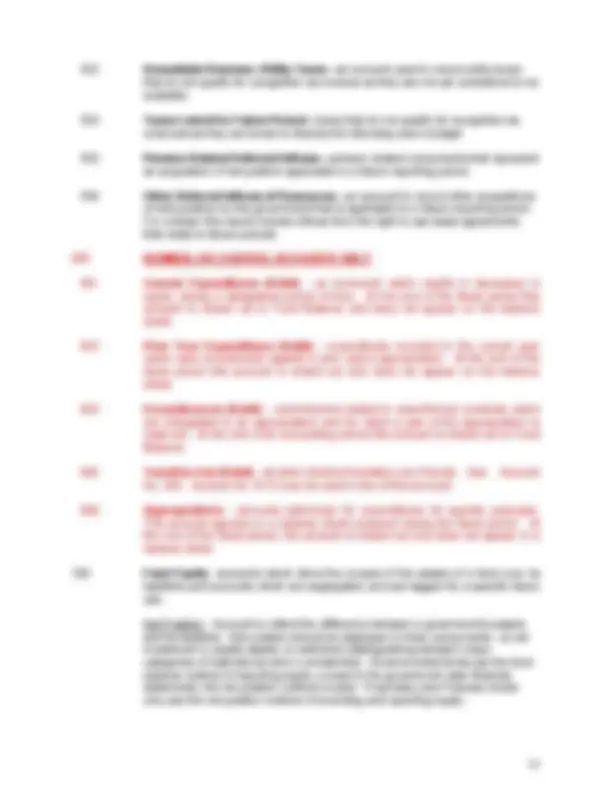
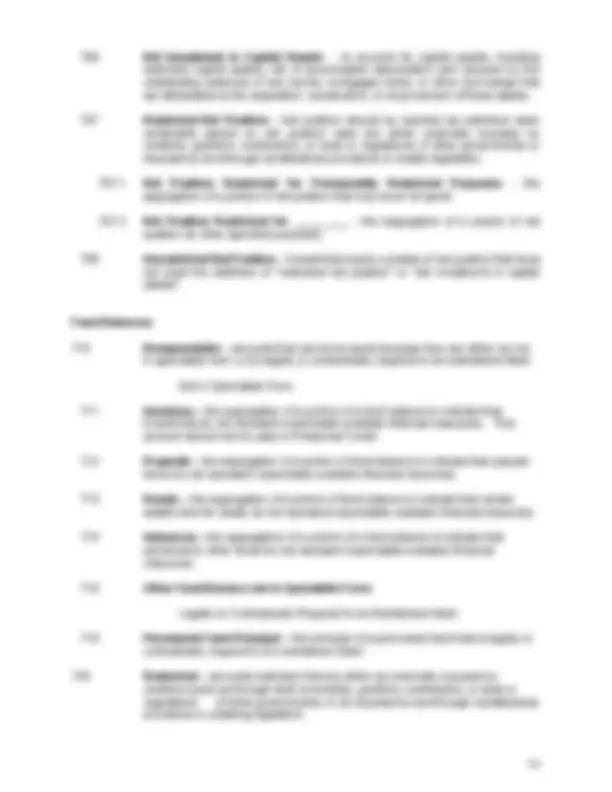
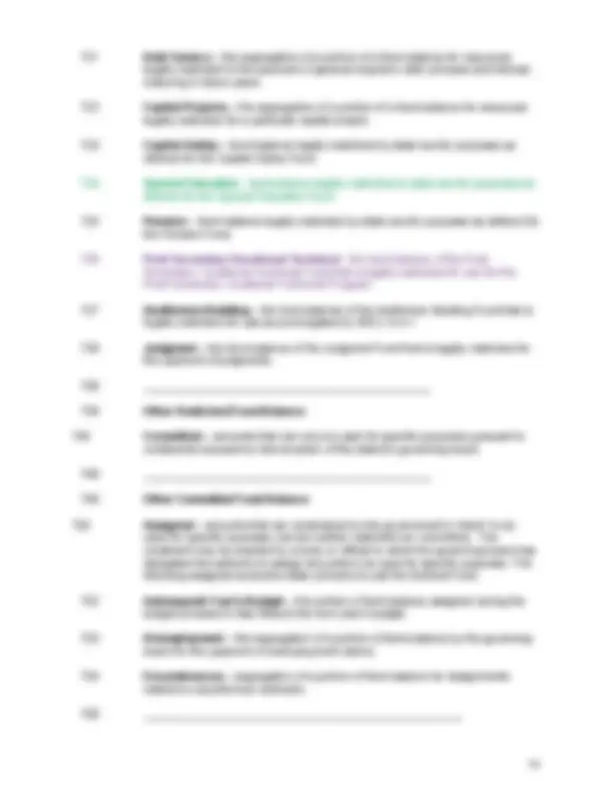


Study with the several resources on Docsity

Earn points by helping other students or get them with a premium plan


Prepare for your exams
Study with the several resources on Docsity

Earn points to download
Earn points by helping other students or get them with a premium plan
Community
Ask the community for help and clear up your study doubts
Discover the best universities in your country according to Docsity users
Free resources
Download our free guides on studying techniques, anxiety management strategies, and thesis advice from Docsity tutors
An overview of various types of cash equivalents, restricted cash, advance payments, accounts receivable, judgments receivable, funds, buildings, improvements other than buildings, machinery and equipment, accumulated depreciation, intangible lease assets, deferred outflows of resources, transfers, accounts payable, judgments payable, construction contracts payable, registered warrants, deferred inflows of resources, and other deferred inflows of resources. It also explains the net position components and fund balance classifications.
What you will learn
Typology: Schemes and Mind Maps
1 / 11

This page cannot be seen from the preview
Don't miss anything!







100 Current Assets - cash or anything that can be readily converted into cash.
Cash and Cash Equivalents - This account will not be used throughout the year but will instead be utilized for financial statement presentation only. All cash and cash equivalents should be aggregated and reported on this account. Cash equivalents are short-term highly liquid investments (less than three months maturity) such as treasuries and mutual funds.
101 Cash/Cash and Deposits - cash on deposit with an official or agent designated as custodian of cash and bank deposits.
102 Petty Cash - money set aside on an imprest basis for the purpose of paying small obligations for which the issuance of a formal voucher or check would be too expensive and time-consuming. (SDCL 13-18-16)
103 Cash Change - money set aside for the purpose of providing change.
104 Cash with Fiscal Agent - deposits with fiscal agents for the payment of matured bonds and interest.
105 Interest Bearing Accounts - cash deposited in an interest bearing account in the designated depository(ies).
106 Savings Certificates - interest bearing certificates purchased from the designated depository(ies).
107 Restricted Cash in Bank - an account that segregates cash deposited in banks which cannot be used for general operations of fund activities.
107.1 Restricted Cash and Cash Equivalents - Cash resources that when purchased have a maturity date of three months or less.
107.2 Restricted Investments - Investments that when purchased have a maturity date of greater than three months.
108 Advance Payments - an incidental account in an amount determined by the board on an imprest basis for advanced payment or for claims requiring immediate payment. (SDCL 13-18-17)
110 Taxes Receivable--Current - the uncollected portion of taxes which a governmental unit has levied and which has become due but which are not yet delinquent.
111 Estimated Uncollectible Taxes Receivable--Current (Credit) - a provision out of tax revenue for that portion of current taxes receivable which it is estimated will not be collected. The account is shown on the balance sheet as a deduction from the Taxes Receivable--Current account to arrive at net current taxes receivable.
112 Taxes Receivable--Delinquent - taxes remaining unpaid on and after the date on which a penalty for nonpayment attaches. Even though the penalty may be subsequently waived and a portion of the taxes abated or canceled, the unpaid balances continue to be delinquent taxes until paid, abated, canceled, or converted into tax liens.
113 Estimated Uncollectible Taxes Receivable--Delinquent (Credit) - that portion of delinquent taxes receivable which it is estimated will not be collected. The account is shown on the balance sheet as a deduction from the Taxes Receivable--Delinquent account to arrive at net delinquent taxes receivable.
120 Accounts Receivable - amounts owing on open account from private persons, firms, or corporations for goods and services furnished by a school district (but not including amounts due from other funds or from other governmental units).
121 Bond Proceeds Receivable - an account used to designate the amount receivable upon sale of bonds.
122 Judgments Receivable - an amount to be received as a result of court decisions, including condemnation awards in payment for private property taken for public use.
123 Notes Receivable - an amount to be received resulting from a promissory note.
124 Due from Component Unit - amounts owed by a discretely presented component unit to a primary government as a result of goods or services provided or loans made to the discretely presented component unit.
125 Lease Receivable – an amount to be collected by the School (lessor) as a result of right to use lease agreements.
130 Due from __________ Fund - an asset account used to indicate amounts owed to a fund by another fund in the same school district which are due within one year. Separate accounts should be maintained for each interfund receivable.
140 Due from __________ Government - amounts due to the school district from another governmental unit. These amounts may represent grants-in-aid, shared taxes, loans and charges for services rendered by the school district for another government.
150 Advance to __________ Fund - an asset account used to indicate amounts owed to the fund by another fund in the same governmental unit which is not due within one year.
162 Interest Receivable on Investments and Deposits - the amount of interest receivable on investments and deposits, exclusive of interest purchased. Interest purchased should be shown in a separate account.
163 Accrued Interest on Investments Purchased - interest accrued on investments between the last interest payment date and date of purchase.
170 Inventories-Materials and Supplies – materials and supplies on hand for future consumption.
202 Buildings - a capital asset account which reflects the acquisition value of permanent structures owned by the school district. If buildings are purchased or constructed, this account includes the purchase or contract price of all permanent buildings and fixtures attached to and forming a permanent part of such buildings (building improvements, HVAC systems, etc.). If buildings are acquired by gift, the account reflects their appraised value at time of acquisition.
203 Improvements Other Than Buildings - a capital asset account which reflects the acquisition value of permanent improvements, other than buildings, which add value to land. The Improvements Other than Buildings also include Infrastructure assets which are tangible property that is normally both stationary in nature and can be preserved for significantly greater number of years than other types of tangible property. Examples of such improvements are fences, retaining walls, sidewalks, pavements, gutters, tunnels, roads and bridges. If the improvements are purchased or constructed, this account contains the purchase or contract price. If improvements are obtained by gift, it reflects the appraised value at time of acquisition.
204 Machinery and Equipment--Local Funds - tangible property of a more or less permanent nature, other than land or buildings and improvements thereon, which is purchased with local funds.
205 Machinery and Equipment--Federal Assistance - tangible property of a more or less permanent nature, other than land or buildings and improvements thereon, which is purchased with federal funds. (This account is used for Food Service capital assets only. GCA will use account No. 204 for equipment.)
206 Construction/Development in Progress - the cost of construction/development undertaken but not yet completed.
208 Accumulated Depreciation--Machinery and Equipment--Local Funds (Credit) - the accumulation of periodic credits made to record the expiration of the estimated useful life of capital assets acquired with local funds.
209 Accumulated Depreciation--Machinery and Equipment--Federal Assistance (Credit) - the accumulation of periodic credits made to record the expiration of the estimated useful life of capital assets acquired with federal funds.
210 Accumulated Depreciation--Buildings (Credit) -- the accumulation of periodic credits made to record the expiration in the service life of buildings which is attributable to wear and tear through use and lapse of time, obsolescence, inadequacy or other physical or functional cause.
211 Accumulated Depreciation—Improvements Other than Buildings (Credit) -- the accumulation of periodic credits made to record the expiration of estimated service life of improvements other than buildings.
212 Intangible Assets – a capital asset that lacks physical substance, is non- financial in nature and has an initial useful life extending beyond a single reporting period. Examples of intangible assets are easements, water rights, patents, trademarks and computer software. (Categories of intangible assets that are significant should be reported as separate classes of capital assets. Software, water rights, etc.)
213 Accumulated Amortization (Credit) – The accumulation of allocations of estimated amortization of an intangible asset.
214 Intangible Lease Assets - a capital asset account which reflects the intangible right to use lease assets. Lease assets are classified for reporting purposes according to the classification of the underlying capital assets.
215 Accumulated Amortization – Lease Assets (Credit) -- the accumulation of allocations of estimated amortization of intangible right to use lease assets.
250 Deferred Outflows of Resources – a consumption of net position by the government that is applicable to a future reporting period.
251 Deferred Charge on Refunding —account used to record the debit amounts resulting from the refunding of debt.
252 Pension Related Deferred Outflows— pension related components that represent a consumption of net position applicable to future reporting period.
259 Other Deferred Outflows of Resources —account used to record other consumptions of net position by the government that is applicable to a future reporting period.
300 NOMINAL OR CONTROL ACCOUNTS ONLY
301 Revenue (Credit) - financial resource increments which result in increases in equity during a designated period of time. At the end of the fiscal period the account is closed out to Fund Balance and does not appear on the balance sheet prepared at the close of the fiscal period.
305 Transfers In (Credit) - all other interfund transfers into funds; e.g., legally authorized transfers from a fund receiving revenue to the fund through which the resources are to be expended, transfers of tax revenues from a Special Revenue Fund to a Debt Service Fund, transfers from the General Fund to a Special Revenue or Capital Projects Fund, and operating subsidy transfers from the General or a Special Revenue Fund to an Enterprise Fund. Account No. 5110 may be used in Lieu of this account.
306 Estimated Revenue - the amount of revenue estimated to be received or to become receivable during the fiscal period. At the end of such period, the amount is closed out and does not appear in a balance sheet.
LIABILITIES, DEFERRED INFLOWS OF RESOURCES, AND EQUITY
400 Current Liabilities - those liabilities the school district expects to pay within a short period of time, usually within a year.
401 Vouchers Payable - liabilities for goods or services received as evidenced by vouchers which have been preaudited and approved for payment but which have not been paid.
402 Accounts Payable - liabilities on open account owing to private persons or organizations for goods and services received by a school district (not including
450 Payroll Deductions and Withholdings and Employer Matching Payable - amounts deducted from employees’ salaries for withholding taxes, other purposes and employer matching. A separate liability account may be used for each type of deduction.
451 Compensated Absences Payable – Current – the current portion of amounts owed employees for unpaid vacation, sick and other leave benefits. (see also account 504)
471 Deposits Payable - liabilities for deposits received as a prerequisite to providing or receiving services and/or goods.
472 Due to Fiscal Agent - amounts due to fiscal agents for servicing a school district’s maturing indebtedness.
473 Unamortized Premiums on Bonds Sold - the portion of the excess of bond proceeds over par value and which remains to be amortized over the remaining life of such bonds.
475 Unearned Revenue – a liability of resources obtained prior to revenue recognition.
500 Long-Term Liabilities - debts with a maturity over one year from date of issuance.
501 Bonds Payable - the face value of bonds issued and outstanding.
502 C.O. Certificates Payable - the value of capital outlay certificates outstanding.
504 Compensated Absences Payable - a long-term liability for future vacation, sick and other leave benefits.
505 Early Retirement Benefits Payable - the value of early retirement benefits outstanding.
506 Net OPEB Obligation – The cumulative difference since the effective date of GASB45 between annual Other Postemployment Benefits (OPEB) cost and the employer’s contributions to the plan, if any.
507 Net Pension Liability – account used to record the amount in which the total pension liability exceeds the pension plan’s fiduciary net position.
508 Lease Liability – liability account used to account for present value of future lease payments to be made by the School (Lessee) for the right to use leased assets.
509 Other Long-Term Liabilities – a liability account used to record other types of long-term debt. Includes long-term notes payable.
550 Deferred Inflows of Resources— an acquisition of net position by the government that is applicable to a future reporting period.
551 Unavailable Revenue--Property Taxes— an account used to record property taxes that do not qualify for recognition as revenue as they are not yet considered to be available.
552 Unavailable Revenue--Utility Taxes— an account used to record utility taxes that do not qualify for recognition as revenue as they are not yet considered to be available.
553 Taxes Levied for Future Period— taxes that do not qualify for recognition as revenues as they are levied to finance the following year’s budget.
554 Pension Related Deferred Inflows— pension related components that represent an acquisition of net position applicable to a future reporting period.
559 Other Deferred Inflows of Resources— an account to record other acquisitions of nets position by the government that is applicable to a future reporting period. For a lessor this would include inflows from the right to use lease agreements that relate to future periods.
600 NOMINAL OR CONTROL ACCOUNTS ONLY
601 Current Expenditures (Debit) - an increment which results in decreases in equity during a designated period of time. At the end of the fiscal period this account is closed out to Fund Balance and does not appear on the balance sheet.
602 Prior Year Expenditures (Debit) - expenditures recorded in the current year which were encumbered against a prior year’s appropriation. At the end of the fiscal period this account is closed out and does not appear on the balance sheet.
603 Encumbrances (Debit) - commitments related to unperformed contracts which are chargeable to an appropriation and for which a part of the appropriation is reserved. At the end of an accounting period this account is closed out to Fund Balance.
605 Transfers Out (Debit) - all other interfund transfers out of funds. See Account No. 305. Account No. 8110 may be used in lieu of this account.
606 Appropriations - amounts authorized for expenditures for specific purposes. This account appears in a balance sheet prepared during the fiscal period. At the end of the fiscal period, the account is closed out and does not appear in a balance sheet.
700 Fund Equity accounts which show the excess of the assets of a fund over its liabilities and accounts which are segregated, and ear tagged for a specific future use.
Net Position - Account to reflect the difference between a government's assets and its liabilities. Net position should be displayed in three components - a) net investment in capital assets; b) restricted (distinguishing between major categories of restrictions) and c) unrestricted. Governmental funds use the fund balance method of reporting equity, except in the government wide financial statements, the net position method is used. Proprietary and Fiduciary funds only use the net position method of recording and reporting equity.
721 Debt Service – the segregation of a portion of a fund balance for resources legally restricted to the payment of general long-term debt principal and interest maturing in future years.
722 Capital Projects – the segregation of a portion of a fund balance for resources legally restricted for a particular capital project.
723 Capital Outlay – fund balance legally restricted by state law for purposes as defined for the Capital Outlay Fund.
724 Special Education - fund balance legally restricted by state law for purposes as defined for the Special Education Fund.
725 Pension – fund balance legally restricted by state law for purposes as defined for the Pension Fund.
726 Post Secondary Vocational-Technical - the fund balance of the Post- Secondary Vocational-Technical Fund that is legally restricted for use for the Post Secondary Vocational-Technical Program.
727 Auditorium Building – the fund balance of the Auditorium Building Fund that is legally restricted for use as promulgated by SDCL 6-4-1.
728 Judgment – the fund balance of the Judgment Fund that is legally restricted for the payment of judgments.
738 _______________________________________________
739 Other Restricted Fund Balance
740 Committed – amounts that can only be used for specific purposes pursuant to constraints imposed by formal action of the district’s governing board.
748 _______________________________________________
749 Other Committed Fund Balance
750 Assigned – amounts that are constrained by the government’s “intent” to be used for specific purposes, but are neither restricted nor committed. The constraint may be enacted by a body or official to which the governing board has delegated the authority to assign amounts to be used for specific purposes. The following assigned accounts relate primarily to just the General Fund.
752 Subsequent Year’s Budget – the portion of fund balance assigned during the budget process to help finance the next year’s budget.
753 Unemployment – the segregation of a portion of fund balance by the governing board for the payment of unemployment claims.
754 Encumbrances – segregation of a portion of fund balance for assignments related to unperformed contracts.
758 ____________________________________________________
759 Other Assigned Fund Balance
760 Unassigned – Unassigned fund balance is the residual classification for the General Fund. The General Fund should be the only fund that reports a positive unassigned fund balance amount.